#8: Coenzymes & One-Carbon Metabolism
1/96
Earn XP
Description and Tags
Name | Mastery | Learn | Test | Matching | Spaced |
|---|
No study sessions yet.
97 Terms
Suppose cells have generated amino acid _______ _________ after degrading amino acids and releasing free NH3. In MUSCLE cells, _______ ________ are further __________, enter ____________ or the ______ ______ ______, and are used for _____ ___________.
carbon skeletons, carbon skeletons, degraded, glycolysis, citric acid cycle, ATP production
Suppose cells have generated amino acid _______ _________ after degrading amino acids and releasing free NH3. In LIVER cells, _______ ________ are further __________, enter ____________ or the ______ ______ ______, and are used for _____ ___________. They can also be used to ____________ ____ or in __________________. How we use _______ _________ in the liver is determined by the body’s _______ ______ (so whether we have just eaten or are fasting).
carbon skeletons, carbon skeletons, degraded, glycolysis, citric acid cycle, ATP production, synthesize fats, gluconeogenesis, carbon skeletons, energy state
Amino acid degradation and synthesis is closely linked with ___________ and the ______ ______ ______.
glycolysis, citric acid cycle
________ ________ are degraded and enter the ______ ______ _______ as select _________________. Amino acids can be classified as ___________ (when they are being used to produce _________) or ___________ (when they are being used to produce _____ or _________ ________). Some amino acids can be used for both.
carbon skeletons, citric acid cycle, intermediates, glucogenic, glucose, ketogenic, fats, ketone bodies
Are the amino acids that enter the TCA cycle as pyruvate GLUCOGENIC or KETOGENIC?
glucogenic
Are the amino acids that enter the TCA cycle as acetyl-CoA GLUCOGENIC or KETOGENIC?
ketogenic
Are the amino acids that enter the TCA cycle as AcetoAcetate GLUCOGENIC or KETOGENIC?
ketogenic
Are the amino acids that enter the TCA cycle as glutamate GLUCOGENIC or KETOGENIC?
glucogenic
Are the amino acids that enter the TCA cycle as succinyl-CoA GLUCOGENIC or KETOGENIC?
glucogenic
Are the amino acids that enter the TCA cycle as fumarate GLUCOGENIC or KETOGENIC?
glucogenic
Are the amino acids that enter the TCA cycle as aspartate GLUCOGENIC or KETOGENIC?
glucogenic
Are the amino acids that enter the TCA cycle as oxaloacetate GLUCOGENIC or KETOGENIC?
glucogenic
Name the 5 major glucogenic amino acids
alanine, glutamate, glutamine, aspartate, asparagine
Name the 2 major ketogenic amino acids
leucine, lysine
Humans can synthesize ___ out of the 20 common amino acids. Amino acids that an organism cannot synthesize in __________ _________ under a given set of conditions are “_____________”. Those that CAN be synthesized in _________ __________ are “_______________”. Most bacteria and plants can synthesize ___ out of the 20 common amino acids. _____________ and the _______ ______ ______ provide building blocks for the synthesis of ___ out of the ___ ______________ amino acids.
10, adequate amounts, essential, adequate amounts, nonessential, 20, glycolysis, citric acid cycle, 9, 10 nonessential
Name the 2 amino acids that humans can synthesize BUT generally not in sufficient amounts
arginine (Arg), methionine (Met)
Name the 10 nonessential amino acids (amino acids that the body can synthesize in sufficient amounts)
alanine (Ala), asparagine (Asn), asparate (Asp), glutamate (Glu), serine (Ser), glutamine (Gln), cysteine (Cys), glycine (Gly), proline (Pro), tyrosine (Tyr)
Draw the picture showing how glycolysis and the citric acid cycle provide building blocks for 9 of the 10 nonessential amino acids (answer in pic)
pic
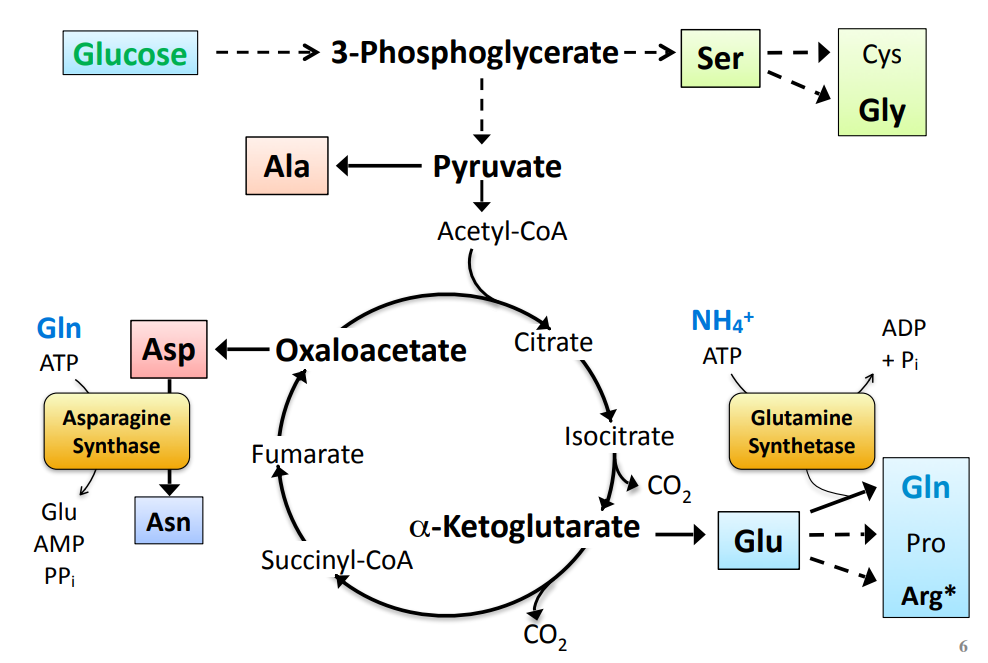
Synthesis of Serine
Start with _________ and run ___________ until you reach the intermediate ___________________.
Run an _________ reaction to form ___________________________. This reaction also generates ________.
Add ___________ and run a ________________ reaction catalyzed by a _____________ that uses _____ as a __________. This produces _____-________________ as well as ________________.
Perform a ___________ reaction to produce _______, which also releases __________ _________. From here you can do a few things:
Switch the ____ group with an ____ group to produce ___________.
Use _____ to run an ______-_____________ reaction to produce _________. This reaction is catalyzed by _______ ______________ ___________ (_______).
glucose, glycolysis, 3-phosphoglycerate, oxidation, 3-phosphohydroxypyruvate, NADH, glutamate, transamination, transaminase, PLP, cofactor, alpha-ketoglutarate, 3-phosphoserine, hydrolysis, serine, inorganic phosphate, OH, SH, cysteine, PLP, alpha-elimination, glycine, Serine HydroxyMethyl Transferase, SHMT
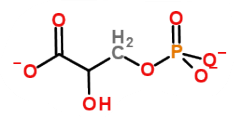
What is this a picture of?
3-phosphoglycerate
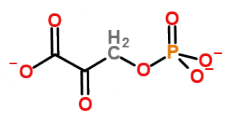
What is this a picture of?
3-phosphohydroxypyruvate
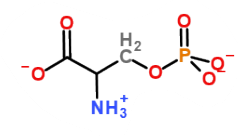
What is this a picture of?
3-phosphoserine
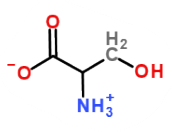
What is this a picture of?
serine (Ser)
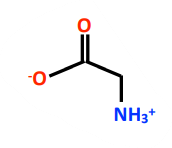
What is this a picture of?
glycine (Gly)
The coenzyme ___________ __________ (____) can catalyze much more than transaminase reactions. It can catalyze reactions at the _______, _______, or _______-carbon. Each reaction generates a ____________ that is stabilized by _____.
Reactions it can catalyze at the _______ carbon include ______________ (used for ______ ______ synthesis and degradation), _______________ (used for the synthesis of ______________________), _____-______________ (used for ______ ______ synthesis), and ____________.
A reaction it can catalyze at the _______-carbon is a _____-______________/_____________ (used for ______ ______ synthesis).
A reaction it can catalyze at the _______-carbon is a _______-_____________/_______________ (used for ______ ______ synthesis).
Pyridoxal Phosphate, PLP, alpha, beta, gamma, carbanion, PLP, alpha, transamination, amino acid, decarboxylation, neurotransmitters, alpha-elimination, amino acid, racemization, beta, beta-elimination/replacement, amino acid, gamma, gamma-elimination/replacement, amino acid
How can PLP be so versatile?
forms a covalent ______ with substrate
stabilizes a __________ created by removing a proton from the _____-carbon via its _____ structure
acts as an “__________ _____”
adduct, carbanion, alpha, ring, electron sink
Q: How does PLP decide which bond gets broken?
A: _______-____________ ___________ → The _______ determines the _________ and controls which bond is broken or formed by controlling the ___________ of the _________. So PLP doesn’t actually decide! Whichever ______ bond you want to break has to be aligned with the __________ ____ _________ ________, and it is the ________ that ________ the ______ bond.
stereo-electronic control, enzyme, substrates, orientation, substrate, sigma, conjugated pi orbital system, enzyme, orients, sigma
Stereo-Electronic Control of PLP Reactions
The formation of a ______ _____ covalently links the ______ ______ substrate to the ____ ________ cofactor. This is the ________ _________.
A proton gets removed from the ______-carbon of the _________, creating a ____________.
When it gets removed, the _________ in the ______ bond that originally connected to the ______ get “snapped” into the _________ ___ ________ ________ so it can be stabilized through _____________ throughout the _____ structure.
This forms a new _____ _____ between the _____-carbon and the ______ group that eventually gets cleaved to form _____.
Schiff’s Base, amino acid, PLP adduct, external aldimine, alpha, substrate, carbanion, electrons, sigma, proton, conjugated pi orbital system, delocalization, ring, Schiff’s base, alpha, amino, PMP
For a transaminase reaction, PLP cleaves the bond between the _______-_______ and the ________. This reaction is catalyzed by a ______________.
alpha-carbon, proton, transaminase
For a decarboxylation reaction, PLP cleaves the bond between the _______-_______ and the _________ (____) group. This reaction is catalyzed by a _______________.
alpha-carbon, carboxyl, CO2, decarboxylase
For an alpha-elimination reaction, PLP cleaves the bond between the ______-______ and the ______-______. This reaction is catalyzed by _______ ________________ ___________ (______).
alpha-carbon, beta-carbon, Serine HydroxyMethyl Transferase, SHMT

What type of reaction catalyzed by PLP is shown by this image?
Between which atoms is the bond being cleaved?
transaminase, alpha-carbon, proton
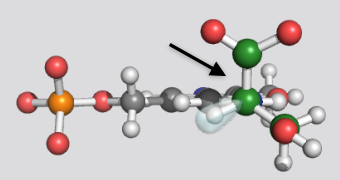
What type of reaction catalyzed by PLP is shown by this image?
Between which atoms is the bond being cleaved?
decarboxylation, alpha-carbon, carboxyl-carbon
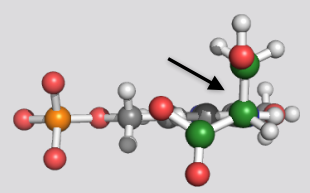
What type of reaction catalyzed by PLP is shown by this image?
Between which atoms is the bond being cleaved?
alpha-elimination, alpha-carbon, beta-carbon
There is a group of biochemical reactions that have a special set of enzymes and ___________. This group of reactions is referred to as ____-________ ___________ because what they have in common is the __________ of ____-_______ groups. They are involved in ______ ______ metabolism and also play roles in ____________ metabolism.
coenzymes, one-carbon metabolism, transfer, one-carbon, amino acid, nucleotide
Name the 4 coenzymes involved in one-carbon metabolism
Biotin, Tetrahydrofolate (THF), S-Adenosyl Methionine (SAM), Cobalamin (Vitamin B12)
How is the coenzyme BIOTIN used? (2)
Name the respective enzymes biotin assists in the above processes
fatty acid synthesis, gluconeogenesis, Acetyl-CoA Carboxylase (ACC), Pyruvate Carboxylase
Which coenzyme carries the most oxidized 1-carbon unit (CO2)?
biotin
How is the coenzyme TETRAHYDROFOLATE (THF) used? (4)
amino acid synthesis, amino acid degradation, nucleotide synthesis, methionine (Met) synthesis
How is the coenzyme S-ADENOSYL METHIONINE (SAM) used? (overall)
methylation
Which coenzyme is used in >40 metabolic reactions?
S-Adenosyl Methionine (SAM)
Which coenzyme is the most reactive of the coenzymes and carries the most reactive form of 1-carbon unit (sulfonium ion)?
S-Adenosyl Methionine (SAM)

What is this a picture of?
Biotin
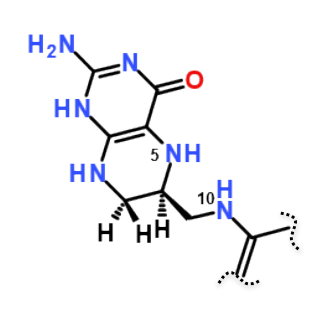
What is this a picture of?
Tetrahydrofolate (THF)
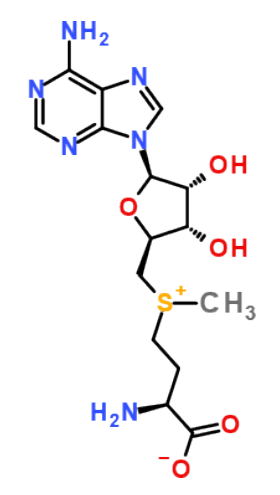
What is this a picture of?
S-Adenosyl Methionine (SAM)
The synthesis of _______ and _______ is the primary link between one-carbon metabolism and coenzymes.
serine, glycine
Synthesis of Glycine from Serine
Requires 2 cofactors: _____ and _________________ (_____)
Start with ________ and use the enzyme _______ ______________ ___________ (_______) to catalyze an ______-____________ reaction, producing ________ and _____. This reaction is stabilized by the coenzyme _____.
The __________ group (aka the ____-carbon that is no longer attached to the _________) is now covalently attached to _____ between ____ and ____. This creates ____,___-___________-_____ which can now _______________ from the enzyme. This reaction is _________, but does not happen often.
PLP, Tetrahydrofolate, THF, serine, Serine HydroxyMethyl Transferase, SHMT, alpha-elimination, glycine, H2O, PLP, methylene, beta, substrate, THF, N5, N10, N5,N10-methylene-THF, dissociate, reversible
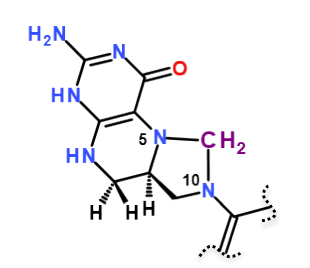
What is this a picture of?
N5,N10-methylene-THF
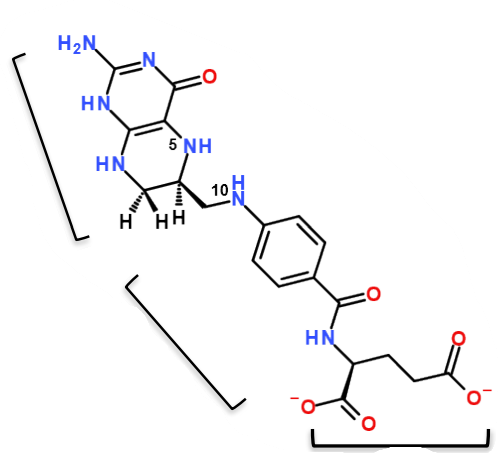
What is the top group in this THF molecule?
Pteridine
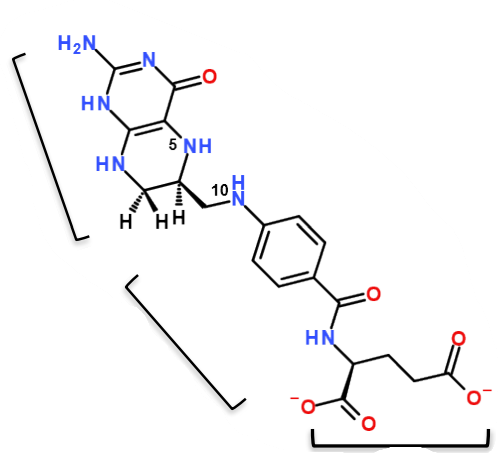
What is the middle group in this THF molecule?
p-AminoBenzoate
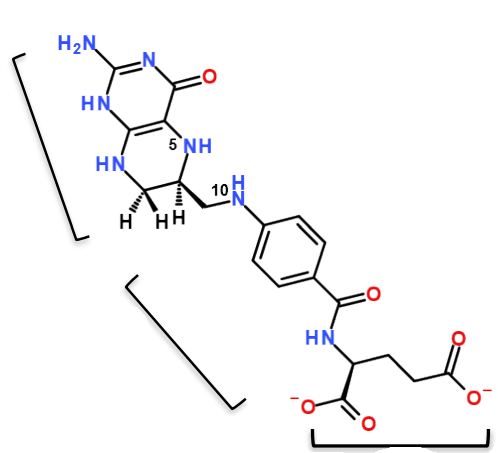
What is the bottom group in this THF molecule?
glutamate (Glu)
How do we make THF?
THF is derived from ________
The enzyme ______________ ___________ catalyzes the conversion
2 molecules of ________ are used
folate, Dihydrofolate Reductase, NADPH
________ (aka ________ ___) is an essential _______ ________ used for amino acid, RNA, and DNA metabolism. Humans cannot __________ _______, so we must get it from our _____. Adequate levels of ________ are critical for _________ _________ development. A deficiency of ________ can cause _______-_____ defects like ______ _______.
folate, Vitamin B9, dietary vitamin, synthesize folate, diet, folate, nervous system, folate, neural-tube, spina bifida
______________ are a class of drugs derived from ______________, which mimics the structure of the ________________ (_____) structure in ____. Many of these drugs are ___________ because they ______ bacteria from ___________ ________, thus killing them. Mammals do not ___________ ________ so they are unaffected.
Sulfonamides, sulfanilamide, p-AminoBenzoate, PABA, THF, antibiotics, inhibit, synthesizing folate, synthesize folate

What is this a picture of?
folate

What is this a picture of?
sulfanilamide
THF can carry 1-carbon units in different ________ states. Once THF is converted into _____-___________-____, from there it can be interconverted into molecules carrying either more _______ forms or more _______ forms of 1-carbon units. Interconverting _____-___________-____ into a more _________ form is __________ and generates _______. Contrastingly, interconverting _____-___________-____ into a more _________ form is _____________ and USES ______.
oxidation, N5,N10-methylene-THF, oxidized, reduced, N5,N10-methylene-THF, oxidized, reversible, NADPH, N5,N10-methylene-THF, reduced, irreversible, NADH
Name the 3 forms of THF that are more OXIDIZED than N5,N10-methylene-THF
N5,N10-Methenyl-THF, N10-Formyl-THF, N5-Formimino-THF
Name the 1 form of THF that is more REDUCED than N5,N10-methylene-THF
N5-Methyl-THF
Is the interconversion of N5-N10-Methylene-THF into a more oxidized form REVERSIBLE or IRREVERSIBLE?
reversible
Is the interconversion of N5-N10-Methylene-THF into a more reduced form REVERSIBLE or IRREVERSIBLE?
irreversible
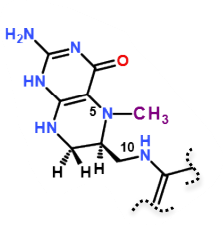
What is this a picture of?
N5-Methyl-THF
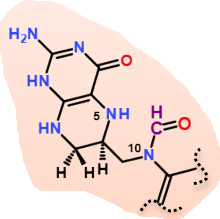
What is this a picture of?
N10-Formyl-THF
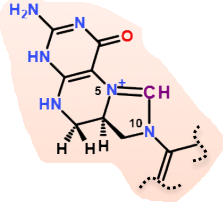
What is this a picture of?
N5,N10-Methenyl-THF
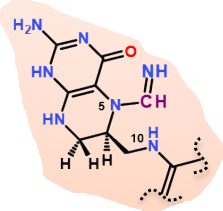
What is this a picture of?
N5-Fomimino-THF
What is the main source of one-carbon units for THF?
conversion of serine to glycine
Which coenzyme catalyzes Histone/DNA methylation for transcriptional regulation?
S-Adenosyl Methionine (SAM)
The Methyl Cycle - Generating S-Adenosyl Methionine (SAM)
Start with _____________. Use 1 ____ to add the ____________ group, producing the coenzyme ___________ ___________ (____).
Remove the ________ group from the ____________ _____ and place it onto a ______ molecule like a ______ or _____. This produces _____________-______________.
Remove the __________ group, releasing __________ and producing ______________.
Using the enzyme __________ ___________ and the 2 coenzymes ____-_________-____ and ___________ (___________ _____), add a ________ group to the ________. This regenerates _____________.
Methionine (Met), ATP, adenosyl, S-Adenosyl Methionine, SAM, methyl, sulfonium ion, target, protein, lipid, S-Adenosyl-Homocysteine, adenosyl, Adenosine, Homocysteine, Methionine Synthase, N5-methyl-THF, Cobalamin, Vitamin B12, methyl, sulfur, Methionine (Met)
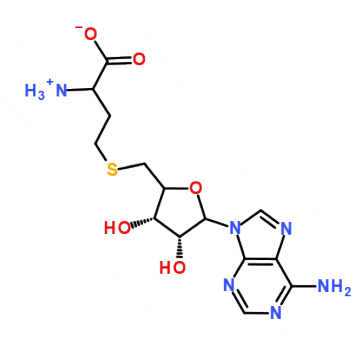
What is this a picture of?
S-Adenosyl-Homocysteine
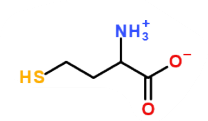
What is this a picture of?
Homocysteine

What is this a picture of?
methionine (Met)
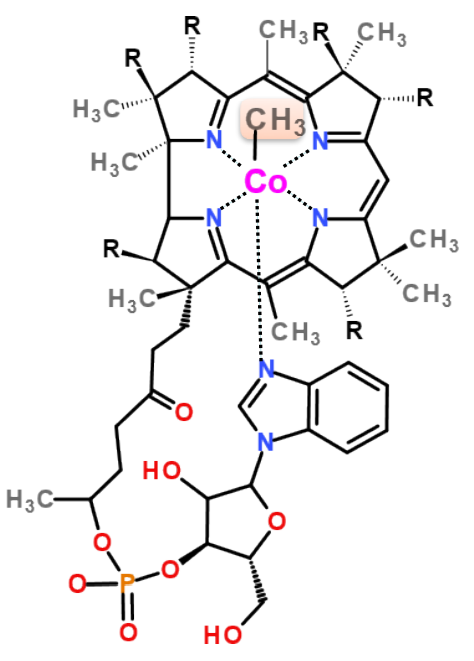
What is this a picture of?
Cobalamin (Vitamin B12)
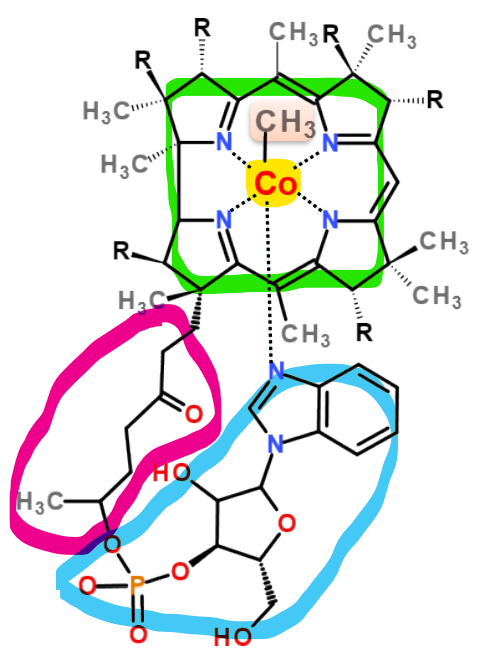
What is being indicated by the YELLOW on the image of Cobalamin?
cobalt
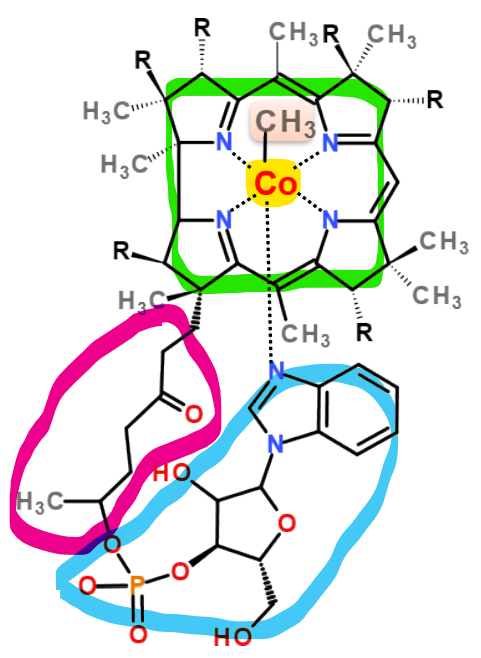
What is being indicated by the GREEN on the image of Cobalamin?
Corrin Ring
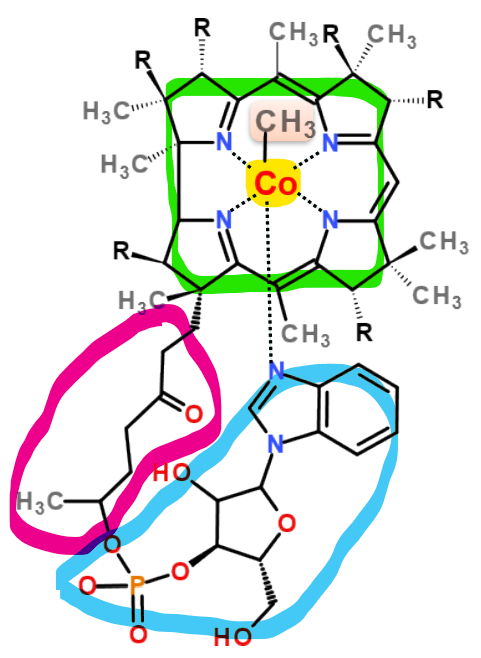
What is being indicated by the BLUE on the image of Cobalamin?
ribose-phosphate
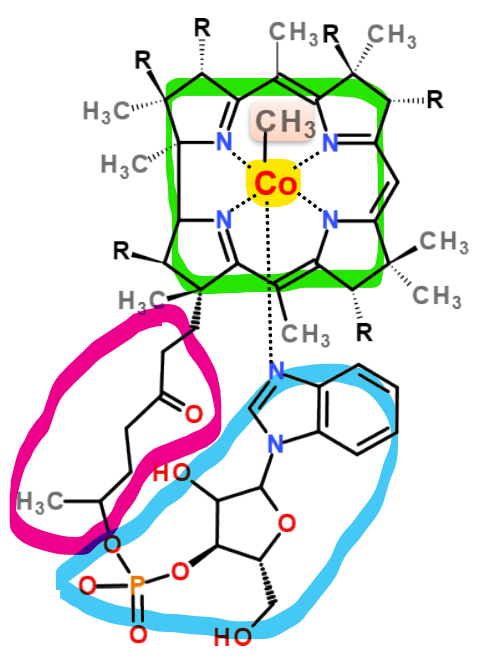
What is being indicated by the PINK on the image of Cobalamin?
benzimidazole
Which coenzyme do humans use for only TWO reactions?
Cobalamin (Vitamin B12)
Humans require Cobalamin for only two reactions:
Conversion of ______________ to ___________ (______ Cycle)
Rearrangement of ________________ to ____________ (____-__________ of odd-chain fatty acids)
homocysteine, methionine, Methyl, MethylMalonyl-CoA, Succinyl-CoA, beta-oxidation
Rearrangement of Methyl-Malonyl-CoA to Succinyl-CoA
Degrade one of the following _________ amino acids: __________, _________, _____________, or ____________. This produces _____________ (3C).
You can also produce ____________ by going through multiple rounds of _____-___________ of odd-chain fatty acids.
Using the coenzyme ________, perform a ______________ reaction (adds _____) to produce __________________.
Rearrange the carbon-carbon bonds using the enzyme ________________ _________ and the coenzyme ___________. This produces _____________, which can enter the citric acid cycle to produce _________.
glucogenic, isoleucine, valine, methionine, threonine, Propionyl-CoA, Propionyl-CoA, beta-oxidation, Biotin, carboxylation, CO2, MethylMalonyl-CoA, MethylMalonyl-CoA Mutase, Cobalamin, Succinyl-CoA, glucose

What is this a picture of?
methylmalonyl-CoA

What is this a picture of?
propionyl-CoA
Reactions of One-Carbon Metabolism are Closely Linked
The ____-_______ ______ generates ____ intermediates important for amino acid synthesis, nucleotide synthesis, and the regeneration of ____________ used in the _______ _______.
The _______ _______ is important for generating ____ which is used in ____________ reactions involved in biosynthesis, post-translational protein modifications, or epigenetic regulation.
One-Carbon Cycle, THF, methionine, Methyl Cycle, Methyl Cycle, SAM, methylation
Draw the image depicting the One-Carbon Cycle and the Methyl Cycle being linked (answer in pic)
pic
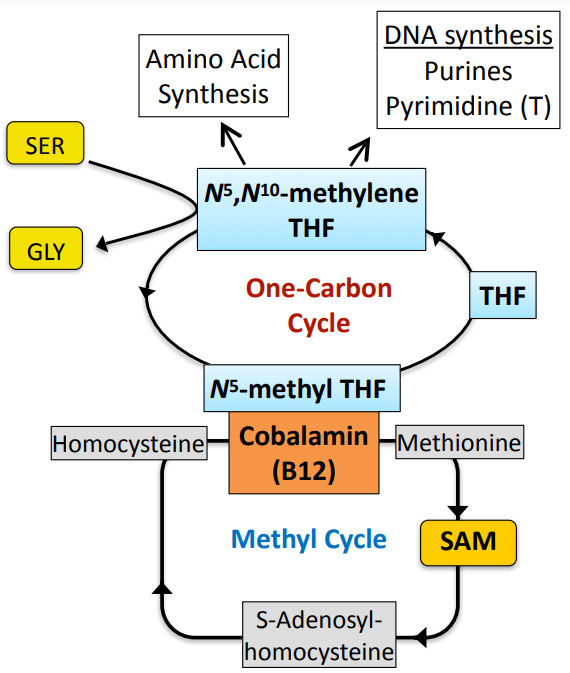
Cobalamin (Vitamin B12) Deficiency
________ _______ is an important protein for absorbing _________ ____ from our diet. A lack of ________ ________ secreted by the cells in our __________ can cause an accumulation of ____-________-_____ and a depletion of _____. Because of the lack of ____ which is required for _____ _____ and ___________ synthesis, our _____ don’t divide or develop properly. They can become very _______ and get trapped in the ______ ________. This causes __________ ________.
Intrinsic Factor, Vitamin B12, Intrinsic Factor, stomach, N5-methyl-THF, THF, THF, amino acid, nucleotide, RBCs, large, bone marrow, Pernicious Anemia
The conversion of serine to glycine utilizes which of the following pairs of cofactors?
A. SAM (also known as adoMet) & ATP
B. PLP & THF
C. B12 & THF
D. Biotin & B12
E. PLP & NADH
B
Enzymes exist that allow interconversion of different forms of THF carrying 1-carbon units except
A. N5,N10 Methylene THF
B. N5,N10 Methenyl THF
C. N5-Methyl THF
D. N10-Formyl-THF
C
Which of the following statements regarding the Cobalamin cofactor are TRUE? Choose the best answer.
A. A genetic defect in the human enzymes required for Cobalamin synthesis from Glycine and Succinyl-CoA result in the disease known as Pernicious Anemia.
B. Methyl-Cobalamin is an intermediate in the reaction catalyzed by Methionine Synthase. The methyl group of methyl-Cobalamin originates from S-adenosylmethionine
C. Cobalamin is used in only two metabolic reactions in humans: 1) Synthesis of Methionine from Homocysteine, and 2) the reaction that converts Methyl-Malonyl-CoA to Succinyl-CoA.
C
The carbon skeletons of which two amino acids enter metabolism at the level of pyruvate? Choose the best answer(s) from the list below.
1- Alanine and Serine
2- Alanine and Cysteine
3- Serine and Asparagine
4- Alanine and Aspartate
A. 3 only
B. 1 and 2
C. 1 only
D. 4 only
E. 2 only
B
Which amino acids are purely ketogenic? Choose the best answer.
A. Leucine and Phenylalanine
B. Leucine and Tryptophan
C. Lysine and Leucine
D. Lysine and Isoleucine
C
Arginine and Methionine are considered essential dietary amino acids because…
A. humans lack enzymes that can synthesize arginine and methionine
B. humans lack the capacity to synthesize arginine and methionine in the amounts necessary.
C. Trick question. Arginine and Methionine are non-essential amino acids for humans.
B
Which ONE of the following statements about pyridoxal-phosphate (PLP) dependent enzymes and the reactions they catalyze is TRUE?
A. In PLP-dependent reactions the α -carbon σ -bond to be broken is oriented perpendicular to the plane of the PLP cofactor.
B. PLP enzymes only catalyze transformations at the α -carbon of amino acids.
C. PLP is only used by the class of enzymes known as aminotransferases.
A
Which of the following amino acids are the purely ketogenic amino acids?
A. Leu and Lys
B. Ile and Leu
C. Glu and Gly
D. Ala and Asp
E. None of the above
A
Which of the following is NOT directly involved in transferring 1-carbon units?
A. Biotin
B. Cobalamin
C. S-Adenosyl-Methionine (SAM)
D. Tetrahydrofolate (THF)
E. Coenzyme A
E
Which of the following enzymes uses Cobalamin (B12) as a cofactor?
A. MethylMalonyl-CoA Mutase
B. Acetyl-CoA Carboxylase
C. Alanine Transaminase
D. Serine HydroxyMethyl Transferase (SHMT)
E. Glutamate Dehydrogenase
A
Which cofactor provides methyl groups for Histone/DNA methylation?
A. Cobalamin
B. S-Adenosyl Methionine (SAM)
C. Tetrahydrofolate (THF)
D. Biotin
E. Coenzyme A
B
Which one of the following does NOT contribute to the formation of MethylMalonate in MethylMalonic Acidemia (MMA) patients?
A. Ile
B. Glu
C. Val
D. Odd chain fatty acids
E. None of the above
B
Which of the following is NOT likely to be the consequence of Folate deficiency based on what you learned in BIOC406?
A. Defect in nucleotide synthesis
B. Impairment in conversion of Serine into Glycine
C. Reduction in Methionine levels
D. Increase in SAM levels
E. None of the above
D